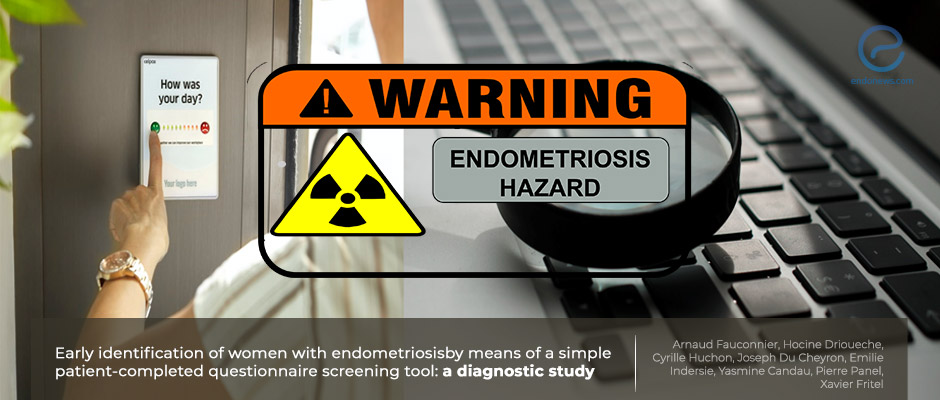A new "survey-based" endometriosis diagnostic tool
Oct 13, 2021
A self-declared symptom-based diagnosis of endometriosis
Key Points
Highlights:
- Symptom-related diagnostic tools pick the women with endometriosis by almost 77% probability rates.
Importance:
- The study provides a self-filled questionnaire program for women who have pain symptoms to give a heads up on endometriosis possibility.
What's done here:
- A French-language accredited version of the questionnaire generated by the World Endometriosis Research Foundation Endometriosis Phenome and Biobanking Harmonisation Project, has been used.
- The endometriosis cases have been chosen from patients applied with symptoms and the presence of endometriosis was confirmed by laparoscopy and histology.
- The control groups were from women who applied to clinics, random women from the society who volunteered to attend, and from women who applied with pain and infertility but have no evidence for endometriosis.
- The sensitivity of the questionnaire of low- and high-risk patients was outlined by the statistical analysis of the full question set model based on binary logistic regression.
Key Results:
- 105 cases and 197 controls including 45 asymptomatic consultation-based controls, 66 women without endometriosis consulting for pain/infertility, and 86 population-based controls have been analyzed.
- The high- and low-risk prediction models would catch endometriosis with posttest probability rates of 77.2% and 0.3% respectively.
- The graphical plot that illustrates the diagnostic ability of this full question set was 0.95 for all controls.
- When symptomatic and asymptomatic controls were separately analyzed, the value slightly decreased to 0.93 for symptomatic controls.
Limitations:
- It is possible that the authors would have missed the peritoneal endometriosis or small nodules of patients with pain in the control group which would affect the results.
- The web-based application model scores each symptom as the same, and it is unknown if the predictivity of any symptom is higher than another.
Lay Summary
Endometriosis is a disease that is diagnosed years after its appearance which causes life quality impairment to patients. It is crucial for the patient to find out the probability of the presence of endometriosis, for applying to healthcare providers before it is too late.
Thinking that "self-completed probability tests would improve diagnostic accuracy and lessen the years missed before diagnosis", a study conducted by Arnaud Fauconnier et al, using the French language accredited version of a questionnaire which was generated by the World Endometriosis Research Foundation Endometriosis Phenome and Biobanking Harmonisation Project. The paper is published in the journal "Fertility and Sterility".
The study group has been chosen from patients applied with symptoms and the presence of endometriosis was confirmed by laparoscopy and histology. The control group was chosen from 3 different backups, women who applied to clinics with routine gynecology checkups, random women from the society who volunteered to attend, and from women who applied with pain and infertility but have no evidence for endometriosis.
The statistical analysis by a graphical plot that illustrates the diagnostic ability of the full question set model revealed 0.95 discrimination power for all controls, and when symptomatic and asymptomatic controls have been separately analyzed, the value slightly decreased to 0.93 for symptomatic controls.
Counting the population rate of endometriosis as 10% the high- and low-risk prediction models would catch endometriosis with posttest probability rates of 77.2% and 0.3% respectively. Given the high accuracy of the results, the authors suggested that these tests can be used by women themselves or by the clinicians on the first step to create a stepwise prediction model and correctly lead women to endometriosis specialists.
Research Source: https://pubmed.ncbi.nlm.nih.gov/34538656/
endometriosis diagnostic tool endometriosis questionnaire early diagnosis surgery histology accuracy survey discrimination

